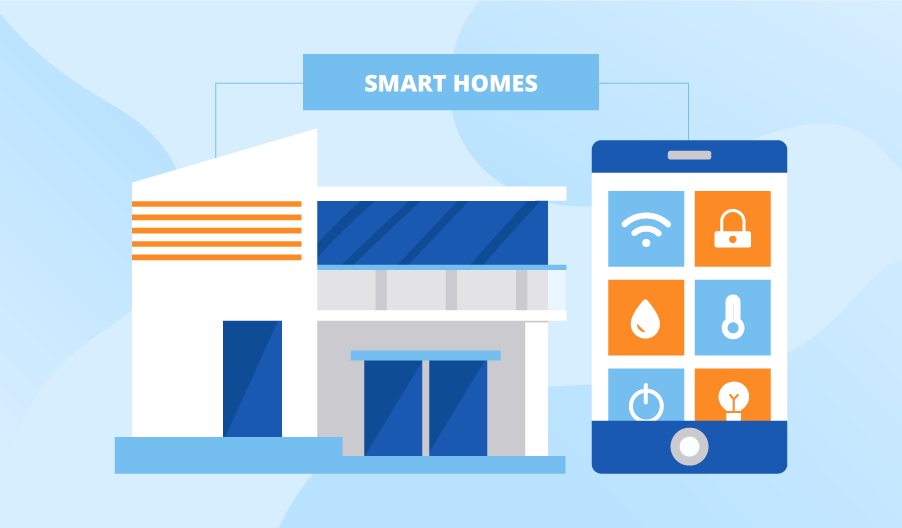Smart Homes: Revolutionizing Modern Living
Editor's note: In the article, Boris dwells on the idea of smart homes and the applications of IoT-based monitoring solutions for smart home enablement. And should you be planning to build a home automation solution, ScienceSoft gladly offers assistance with comprehensive IoT development services.
What makes a home smart?
An idea to make one’s home interconnected, easily operated from one device/appliance is not a new one. As the majority of ground-breaking ideas, it found its place and followers through science fiction novels and continued its path in the early inventions.
According to the UK Department of Trade and Industry (DTI), a smart home is “a dwelling incorporating a communications network that connects the key electrical appliances and services, and allows them to be remotely controlled, monitored or accessed.”

The first rather successful smart-home feature dates back to 1975 Scotland. X10 is a set of protocols that allows home appliances to interact via electrical wires already installed in a house. Being a fantastic invention, it had a visible flaw it could interpret electronic interference from other home appliances as a command and react, or not receive the command at all.
Nowadays smart home is still to be characterized by the same definition. Rather the way of the devices being interconnected is being revised. A home can still be made smart by the way of retro-fitting (the system is incorporated in the existing lines and wires), making it a rather costly undertaking. With the introduction and a rapid development of smart-phone technologies, the smart-home system can be built-in from the beginning and connected to the smart device via radio waves. That’s how Bluetooth, WiFi and cell phone signals operate. Which way would add more convenience to your home?
To sum it up, there are three things a home needs to make it smart:
- Internal network – wire, cable, wireless
- Intelligent control – gateway to manage the systems
- Home automation – links between products, services and external systems
A shortlist of popular smart devices
Devices for monitoring home temperature would be first on the list of most popular devices. Controlled from any device using Wi-Fi, with a self-adjusting based on your habits, Nest Thermostat keeps you cool when you need it most.
Security device Canary includes camera and a siren to successfully ward off burglars, creating a feeling of safety would not be excluded from the list.
Kwikset Kevo is another next-gen utility which stops you from worrying about losing your door-key. To unlock your door using just a finger is definitely what we need. Kevo allows assigning virtual keys permanently or temporarily, monitoring ins and outs, receiving activity alerts via the Kevo app.
Created by Sydney-based company, Ninja Blocks, containing Ninja Blocks as wireless sensors that connect to a home network puts you in control of electronic devices with an option of automatic monitoring. With a set of small USB devices that act as additional nodes and, by analyzing their overlapping Bluetooth low energy (BLE) signals, system constructs a digital 3D model of the environment. It gives almost endless possibilities, since you can program it to look after your keys, or pets (dogs or cats), Ninja Sphere can tell you when they’re missing and will make sure to inform you immediately.
Technologies behind smart home concept. What does it imply?
After taking a look at smart home technologies and popular devices, let’s focus more on the software part of the deal.
OpenHAB open-source automation software creates a platform using about 50 different technologies for integrating smart home appliances and devices. This solution is for creating uniform user interfaces. OpenHAB supports remote access and cares for data security, allowing the user to decide which information to put out there.
Free mobile apps, like Control4 App and Yonomi smart application allow navigating through existing devices by finding and connecting them all together. Yonomi system uses Wi-Fi network to use interconnected devices in creating routines (Calling routine, muting all audio-devices, Welcome home routine, greeting you after a long day at work, etc.). All routines can be additionally programmed to specific time of day, or to specific area of the house. Control4 enables to control your home from any place in the world using 3G/4G or an Internet connection.
Configuration software from Loxone (Loxone Config) comes both as a mobile app and a web interface. This platform provides a simulation mode to test your configuration beforehand. Loxone Config divides Smart Home appliances into more than 60 pre-made blocks like alarm, media control, electricity meter, etc.
Smart Home technologies are here to stay and make our lives easier and evenings at home more enjoyable. As these technologies are getting more wide-spread, there exists no doubt in further, more ample development in this sphere. At ScienceSoft, we strive to become a part of this process, eager to get more experience in Smart Home development and be your ideal outsourcing partner.

